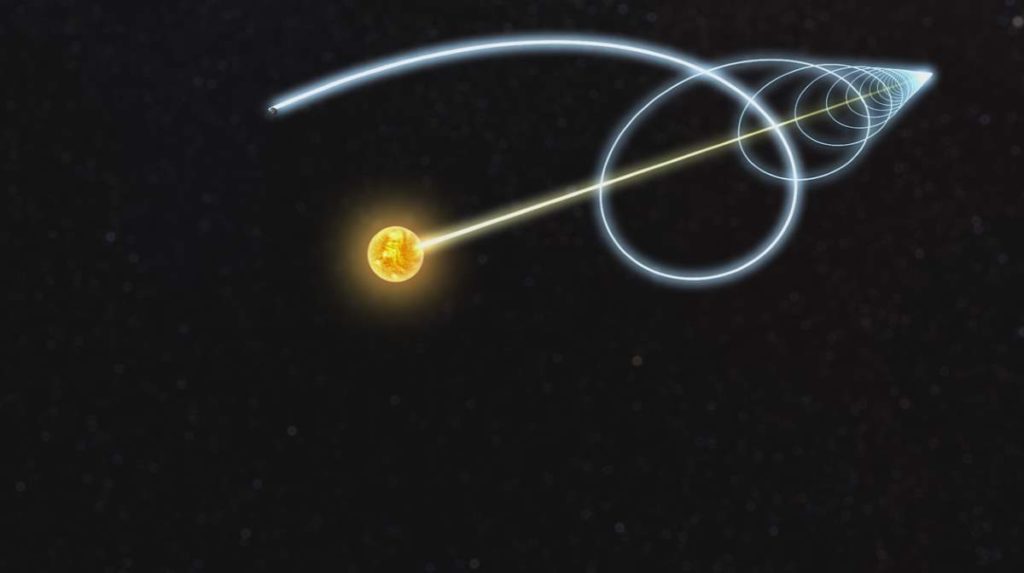In this video, Carl Sagan rides a bicycle and talks about the speed of light. “Something funny happens at the speed of light”.
Carl Sagan explains why the speed of light is a universal constant – transcript of the video above
Is there a method by which we could travel in a conveniently short time to the stars? Can we travel close to the speed of light? And what’s the magic about the speed of light? Can’t we travel faster than that? It turns out that there is something very strange about the speed of light.
Something that provides the key to our understanding of time and space.
The story of its discovery takes us to Tuscany in northern Italy.
There’s something timeless about this place. A century ago, it probably looked very much the same.
If you had traveled these roads in the summer of 1895 you might have come upon a sixteen-year-old German high-school dropout. His teacher had told him that he’d never amount to anything that his attitude destroyed classroom discipline and that he’d be better off out of school.
So he left and came here where he enjoyed wandering these roads and giving his mind free rein to explore.
One day, he began to think about light, about how fast it travels.
In everyday life, we always measure the speed of a moving object relative to something else.
I’m moving at about 10 kilometers an hour relative to the ground. But the ground isn’t at rest. The Earth is turning at more than 1,600 kilometers an hour (roughly 1000 mph). The Earth itself is in orbit around the sun. The sun is moving among the drifting stars, and so on.
It was hard for the young man to imagine some absolute standard to measure all these relative motions against.
He knew that sound waves are a vibration of the air and their speed is measured relative to the air itself. But sunlight travels across the vacuum of empty space. “Do light waves move relative to something else? And if so,” he wondered, “relative to what?”
That teenage dropout’s name was Albert Einstein. And his ruminations changed the world.
He had been fascinated by [Aaron] Bernstein’s 1869 People’s Book of Natural Science (see notes 1).
Here, on its very first page, it describes the astonishing speed of electricity through wires and light through space.
Einstein wondered, perhaps for the first time, in northern Italy, what the world would look like if you could travel on a wave of light. To travel at the speed of light. What an engaging and magical thought for a teenage boy on the road where the countryside is dappled and rippling in the sunlight.
You couldn’t tell you were on a light wave if you were traveling with it. If you started on a wave crest you would stay on the crest and lose all notion of it being a wave.
Something funny happens at the speed of light.
The more Einstein thought about such questions, the more troubling they became. Paradoxes seemed to pop up all over if you could travel at the speed of light.
Certain ideas had been accepted as true without sufficiently careful thought.
One of those ideas had to do with the light from a moving object.
The images by which we see the world are made of light and are carried at the speed of light 300,000 kilometers a second.
You might think that the image of me should be moving out ahead of me at the speed of light plus the speed of the bicycle.
If I’m moving toward you faster than a horse-and-cart then my image should be approaching you exactly that much faster. My image ought to arrive earlier.
But in reality, you don’t see any time delay. In a near collision, for example, you see everything happen at once.
Horse, cart, swerve, bicycle. All simultaneous.
But how would it look if it were proper to add the velocities? Since I’m heading toward you, you’d add my speed to the speed of light. So my image ought to arrive before the image of the horse and cart.
I’d be cycling towards you quite normally. To me, a collision would seem imminent. But you’d see me swerve for no apparent reason and have a collision with nothing.
Now, the horse-and-cart aren’t headed towards you. Their image would arrive only at the speed of light.
Could it seem to me that I just missed colliding while to you it wasn’t even close? In precise laboratory experiments, scientists have never observed any such thing.
If the world is to be understood if we are to avoid logical paradoxes when traveling at high speeds then there are rules which must be obeyed.
Einstein called these rules the special theory of relativity.
Light from a moving object travels at the same speed no matter whether the object is at rest or in motion.
Thou shalt not add my speed to the speed of light. Also, no material object can travel at or beyond the speed of light.
There’s nothing in physics that prevents you from traveling as close to the speed of light as you like. 99.9 percent of the speed of light is just fine.
But no matter how hard you try you can never gain that last decimal point.
For the world to be logically consistent there must be a cosmic speed limit.
The crack of a whip is, due to its tip moving faster than the speed of sound. It makes a shock wave a small sonic boom in the Italian countryside. A thunderclap has a similar origin. So does the sound of a supersonic airplane.
So why is the speed of light a barrier any more than the speed of sound? The answer is not just that light travels a million times faster than sound. It’s not merely an engineering problem like the supersonic airplane.
Instead, the light barrier is a fundamental law of nature as basic as gravity.
Einstein found his absolute framework for the world. This sturdy pillar is among all the relative motions of the cosmos: Light travels just as fast, no matter how its source is moving.
The speed of light is constant, relative to everything else. Nothing can ever catch up with light.
Einstein’s prohibition against traveling faster than light seems to clash with our common sense notions.
But why should we expect our common sense notions to have any reliability in a matter of this sort? Why should our experience at 10 kilometers an hour constrain the laws of nature at 300,000 kilometers a second?
Relativity sets limits on what humans ultimately can do.
The universe is not required to be in perfect harmony with human ambition.

Notes
- Aaron David Bernstein (6 April 1812, Danzig – 12 February 1884, Berlin) was a German Jewish author, reformer, and scientist. The book Sagan mentioned here was actually a multivolume book named From the Field of Natural Science (German: Aus dem Reiche der Naturwissenschaft; 1853-1856), later republished under the title Popular Books on Natural Science (German: Naturwissenschaftliche Volksbücher; 1880)
Sources
- Aaron Bernstein on Wikipedia
- Space Shuttle Endeavour’s Touchdown Meets Columbia’s Salute [An amazing photo from the past] - February 29, 2024
- Moon Landings: All-Time List [1966-2024] - February 23, 2024
- From Orbit to Ordinary: 10 Earthly Applications of Space Technology - January 23, 2024



